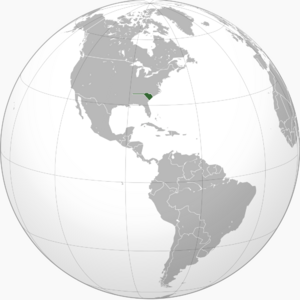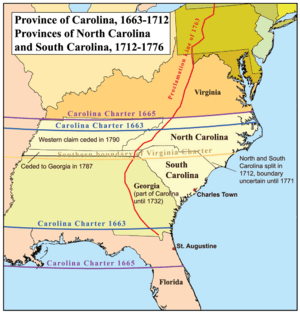Province of South Carolina facts for kids
Quick facts for kids Province of South Carolina |
|||||||||
|---|---|---|---|---|---|---|---|---|---|
| Province of Great Britain | |||||||||
| 1712–1776 | |||||||||
 Location of South Carolina in North America |
|||||||||
| Anthem | |||||||||
| "God Save the King" |
|||||||||
| Capital | Charlestown | ||||||||
| Area | |||||||||
| • Coordinates | 34°N 81°W / 34°N 81°W | ||||||||
| Government | |||||||||
| • Type | Proprietary colony (1712–1729) Crown colony (1729–1776) |
||||||||
| Monarch | |||||||||
|
• 1712–1714
|
Anne | ||||||||
|
• 1714–1727
|
George I | ||||||||
|
• 1727–1760
|
George II | ||||||||
|
• 1760–1776
|
George III | ||||||||
| Governor | |||||||||
|
• 1712
|
Robert Gibbes (first) | ||||||||
|
• 1775–1776
|
Lord William Campbell (last) | ||||||||
| Legislature | General Assembly | ||||||||
|
• Upper house
|
Council | ||||||||
|
• Lower house
|
Assembly | ||||||||
| Historical era | Georgian era | ||||||||
|
• Partition of Carolina
|
24 January 1712 | ||||||||
|
• Charter of Georgia
|
9 June 1732 | ||||||||
| 4 July 1776 | |||||||||
|
|||||||||
| Today part of | United States
|
||||||||
The Province of South Carolina was an important British territory in North America. It existed from 1712 until 1776. This area was one of the original Thirteen Colonies that later formed the United States. It was also one of the five Southern Colonies. The King or Queen of Great Britain ruled the province through a special leader called a Governor. This system lasted until the colonies decided to become independent on July 4, 1776.
Contents
What's in a Name? The Story of Carolina
The name Carolina comes from Carolus. This is the Latin version of the name Charles. It was chosen to honor King Charles I of England. In 1663, King Charles II gave a special document, called a Royal Charter, to eight important noblemen. This charter allowed them to settle a large area of land in North America. This land included what are now the states of North Carolina, South Carolina, Georgia, and several others.
A Look Back: South Carolina's Early Days
Founding Charles Town and Early Settlements
The first main settlement in the area was Charles Town. It was started in 1670. King Charles II had given this large piece of land to eight noblemen. These men were known as the Lords Proprietors. They wanted to create a new colony.
How North and South Carolina Became Separate
At first, Carolina was one big colony. But over time, the northern and southern parts started to develop differently. The Lords Proprietors didn't always pay enough attention to the colony. This led to disagreements about how the province should be run. In 1691, a special deputy governor was chosen to manage the northern half. By 1712, the split was complete, and the area officially became North Carolina and South Carolina.
Challenges and Changes: From Proprietors to Royal Rule
The province faced many challenges. From 1715 to 1717, a conflict called the Yamasee War took place. This war caused a lot of trouble in the countryside. Many people in South Carolina felt that the Lords Proprietors weren't doing enough to protect them. They worried about attacks from local tribes and from the nearby Spanish.
Because of these concerns, a major change happened in 1719. The people of South Carolina rebelled against the Lords Proprietors. They asked King George I to take over. The King agreed and appointed a royal governor for South Carolina that same year. After several years, the British King bought out the Lords Proprietors. By 1729, both North and South Carolina officially became royal colonies. This meant they were directly controlled by the British Crown.
How South Carolina Was Governed
Leaders and Laws
The Province of South Carolina had a government system similar to other British colonies. It was led by a Governor, who represented the King or Queen of Great Britain. There was also a General Assembly, which helped make laws for the colony. This assembly had two parts: the Council and the Assembly.
Population Growth Over Time
The number of people living in the Province of South Carolina grew steadily. Here's a look at how the population changed:
| Historical population | ||
|---|---|---|
| Year | Pop. | ±% |
| 1720 | 17,048 | — |
| 1730 | 30,000 | +76.0% |
| 1740 | 45,000 | +50.0% |
| 1750 | 64,000 | +42.2% |
| 1760 | 94,074 | +47.0% |
| 1769 | 125,000 | +32.9% |
| 1770 | 124,244 | −0.6% |
| 1775 | 150,000 | +20.7% |
| Source: 1720–1760; 1769–1775 1770–1775 | ||
See also
 In Spanish: Provincia de Carolina del Sur para niños
In Spanish: Provincia de Carolina del Sur para niños




